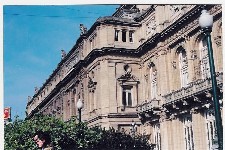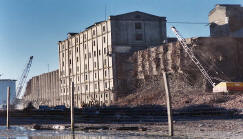|
||||||
|
History
Pre-Columbian Argentina was farmed by sedentary Indian groups such as the Diaguita and used as a hunting ground by nomads. Indian resistance inhibited Spanish incursions and discouraged Spanish settlement. Buenos Aires was not successfully established until 1580, and remained a backwater for 200 years. A declining and unevenly distributed Indian population, which could not be milked for its labor, led to the creation of huge cattle ranches, known as haciendas - the genesis of the legendary gaucho (cowboy) and the source of great wealth for a lucky few. |
|
||
|
Buenos Aires became the capital of the new Viceroyalty of the Río de la Plata in 1776, acknowledgment that the region had outgrown Spain's political and economic domination. However, continuing dissatisfaction with Spanish interference led to the revolution of 25 May 1810 and eventual independence in 1816. Independence revealed the seething regional disparities which Spanish rule had obscured. The Federalists of the interior (conservative landowners, supported by the gauchos and rural working class) advocated provincial autonomy, while the Unitarists of Buenos Aires (cosmopolitan city dwellers who welcomed the injection of European capital, immigrants and ideas) upheld Buenos Aires' central authority. After a disastrous and tyrannical period of rule by the nominally Federalist Juan Manuel Rosas, Buenos Aires and Unitarism prevailed, ushering in a new era of growth and prosperity with the Unitarist constitution of 1853.
Sheep were introduced and the Pampas was given over to the cultivation of cereal crops. European immigration, foreign investment and trade were hallmarks of the new liberalism. However, excessive foreign interests made the economy particularly vulnerable to world economic downturns; wealth was concentrated in the hands of the very few, and unemployment rose as smallholdings failed and farmers were forced to leave the land and head for the cities.
The first decades of the 20th century saw increasingly weak civilian rule, economic failure, continuing resentment of the landed elite and distrust of British interests, leading to a military coup in 1943 which paved the way for the rise of dictator Juan Perón. An obscure colonel with a minor post in the labor ministry, he won the presidency in 1946 and again in 1952. With his equally popular and charismatic wife Eva at his side, he instituted a stringent economic program which stressed domestic industrialization and self-determination, appealing to both the conservative nationalist and working-class factions. His party was squashed by a military coup in 1955, leading to Perón's banishment to Spain and initiating 30 years of disastrous military rule, interspersed by only brief periods of civilian rule. Perón returned to rule briefly in 1973, dying in office in 1974 and bequeathing power to his third wife, Isabel. Increasing economic problems and political instability led to strikes, political kidnappings and guerrilla warfare. Isabel's government fell in 1976, and the new military government instituted a reign of terror.
The years 1976 to 1983 have been described as the years of the Dirty War. Opposition and criticism were eradicated by paramilitary death squads which operated with the state's complicity, bringing about the 'disappearance' of between 10,000 and 30,000 citizens. The most famous victims of this period were the Madres de la Plaza de Mayo, women who bravely kept an open, public vigil for the 'disappeared' members of their families, and who often 'disappeared' themselves.
This internal conflict ironically came to an end only with the emergence of a 'real' war in the south Atlantic: the battle for the Malvinas/Falklands. General Leopold Galtieri seized the Malvinas from the British to distract attention from Argentina's appalling political corruption and economic mismanagement. Surges of nationalistic hysteria in both countries resulted in a British flotilla sailing across the world to save one of the few remaining pink bits on the map. Britain was the eventual 'victor' in what was a mutually shameful and costly episode. Ownership of the Malvinas, however, remains disputed. In June 1995, the Argentine foreign minister offered to buy the islands, offering each of the 2000 islanders US$800,000 for their nationality. The matter has been further complicated by Britain's belief that oilfields lie offshore, and further bickering seems likely.
President Fernando de la Rua of the UCR center-left Alliance, elected to a four-year term in 1999, promised a crackdown on corruption and tough fiscal measures to balance Argentina's budget. But after four years of recession and with an unemployment rate of more than 20%, the Argentine people had enough. De la Rua's austerity plans prompted nationwide strikes and demonstrations, which grew violent after the government instituted harsh restrictions on bank withdrawals. Argentina plunged into economic and political turmoil in December 2001 when it defaulted on a US$132 billion loan repayment - the largest default in history. De la Rua and many of his government ministers resigned amid rioting, looting and widespread civil chaos in which 27 people were killed.
On January 1, 2002, Eduardo Duhalde became Argentina's fifth president in two weeks. A staunch Perónist, Duhalde takes a populist and protectionist stance, though a skeptical public has not forgotten the corruption scandals that clouded his term as governor of Buenos Aires. One of his first moves was to unpeg the peso from the dollar; the currency devalued by more than 50% almost immediately. The move was unpopular but necessary to secure any further aid from the International Monetary Fund.
In a positive sign, the devalued peso has done better than expected in the world currency market, though government imposed banking restrictions may account for its relative strength. Duhalde plans to make sweeping changes to Argentine government, including scrapping the current presidential system for a parliamentary democracy. The public remains dubious about such reforms however, as economic strife and government corruption seem to be endemic here. Protests continue almost daily, strikes are in the works and frustrated people who can't get to their money have vandalized banks. If conditions don't improve soon, Duhalde may have trouble on his hands.
But despite the continuing protests and the long lines at currency exchanges, the violence has for the most part eased and the stage of siege has been lifted. Argentines are waiting warily for word from the IMF (although many blame that organization for causing the crisis) and keeping a worried eye out for the return of hyperinflation. Argentina's climb out of this ever-deepening financial pit promises to be long and arduous. |
|||


